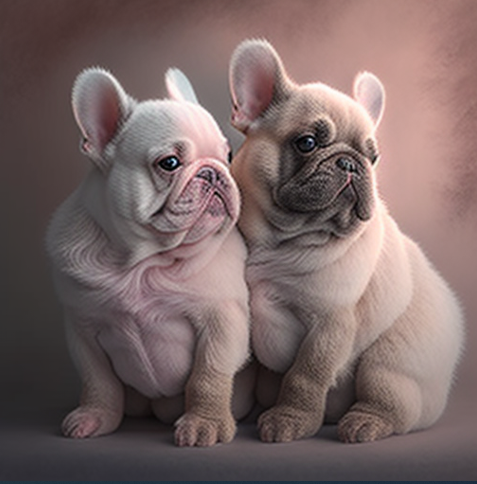French bulldogs are one of the most popular breeds in the world, and for good reason. These adorable pups are known for their unique “bat ears” and charming personalities. If you’re considering adding a French bulldog to your family, you’re in for a real treat. In this comprehensive guide, we’ll walk you through everything you need to know about caring for your new fluffy friend.
- Is a fluffy French Bulldog rare?
- How do you know if my Frenchie is a fluffy carrier?
- What is the most expensive fluffy French Bulldog?
- Understanding the French Bulldog Breed
- Choosing the Right French Bulldog Breeder
- What is the difference between l1 and l4 Fluffy?
- Understanding L1 Fluffy
- Understanding L4 Fluffy
- Determining the Right Fluffy for Your Pet
- Grooming Requirements for L1 and L4 Fluffy
- How big do fluffy Frenchies get?
- The average weight of French bulldogs
- The difference between male and female Frenchies
- Preparing for Your New Fluffy French Bulldog
- Training and Socializing Your French Bulldog
- Feeding Your Fluffy French Bulldog
- Exercise and Playtime for Your French Bulldog
- Grooming Your Fluffy French Bulldog
- French Bulldog Health Concerns
- Conclusion
- FAQs
Is a fluffy French Bulldog rare?
No, the fluffiness of a French Bulldog is not an indicator of rarity. Some Frenchies have a gene that causes them to grow a thicker, longer coat, which gives them a fluffier appearance. This gene is not exclusive to any specific bloodline or breed and can be found in both purebred and mixed Frenchies. While fluffier Frenchies may look different from the more common short-haired variety, it doesn’t necessarily make them rare or more valuable.
How do you know if my Frenchie is a fluffy carrier?
The presence of the “fluffy” gene in French Bulldogs can be determined through genetic testing. This gene is responsible for producing an excessive amount of coat, leading to the “fluffy” appearance. Some dogs may carry the gene but not show any physical signs of it, which is referred to as being a “carrier.” To determine if your French Bulldog is a carrier of the fluffy gene, you can have a DNA test done by a veterinarian or a specialized laboratory. These tests can give you insight into your dog’s genetic makeup, including the presence of any potential health concerns and inherited traits.
What is the most expensive fluffy French Bulldog?
The price of a fluffy French Bulldog can vary depending on several factors, including its lineage, rarity, and overall appearance. However, some of the most expensive fluffy Frenchies can sell for tens of thousands of dollars. It’s important to note that purchasing a dog solely based on its price is not recommended, as there are many unethical breeders and puppy mills that charge high prices for dogs that may not be healthy or well-cared for.
It’s always best to research breeders and choose one that has a good reputation for breeding healthy, well-tempered dogs. You should also make sure to visit the breeder and see the conditions in which the puppies are raised before making a purchase. A responsible breeder will be willing to answer your questions and provide information about the parents and any health clearances.
Understanding the French Bulldog Breed
French bulldogs, also known as “frenchies,” are a small breed that typically weigh between 16 and 28 pounds. They were originally bred to be bull-baiting dogs in England, but over time they evolved into the friendly and affectionate companions we know and love today. Frenchies are a muscular breed with a compact and sturdy build, and they come in a variety of colors including brindle, fawn, black, and white.

Choosing the Right French Bulldog Breeder
When it comes to finding the perfect French bulldog, it’s important to choose the right breeder. Not all breeders are created equal, and it’s crucial to choose one that you trust to provide you with a healthy, happy pup. Here are a few things to look for when choosing a breeder:
- A reputable breeder should be transparent about their breeding practices and should be able to provide you with references.
- The breeder should be able to provide you with a health guarantee for your pup.
- The breeder should be able to provide you with all necessary documents, such as a pedigree, registration papers, and health certificates.
- A good breeder will socialize their puppies from an early age and provide them with proper veterinary care.
What is the difference between l1 and l4 Fluffy?
Fluffy, a term used in the pet industry, refers to the thickness and texture of a pet’s fur. There are several different types of fluffiness, ranging from L1 to L4. Each level represents a different level of thickness and texture in the pet’s fur. In this article, we’ll explore the differences between L1 and L4 Fluffy, and how to determine which one is best for your pet.
Understanding L1 Fluffy
L1 Fluffy, also known as single coat, is the thinnest type of fluffy. It is characterized by a single layer of fur, with a smooth and silky texture. Pets with L1 Fluffy have minimal undercoat, which means they are less prone to matting and tangling. This type of fluffy is most common in pets with short hair, such as bulldogs, boxers, and beagles.
Understanding L4 Fluffy
L4 Fluffy, on the other hand, is the thickest type of fluffy. It is characterized by a thick and dense undercoat, with a soft and fluffy outercoat. Pets with L4 Fluffy have a luxurious and plush appearance, but they require a lot of grooming to maintain their appearance. This type of fluffy is most common in pets with long hair, such as shih tzus, bichons, and poodles.
Determining the Right Fluffy for Your Pet
When choosing a pet, it’s important to consider their breed and coat type. L1 Fluffy is best for pets who have a low maintenance lifestyle, as they require minimal grooming. On the other hand, L4 Fluffy is best for pets who have
It’s also important to consider the climate in which you live. Pets with L4 Fluffy are best suited for colder climates, as their thick and dense coat provides warmth and protection from the elements. Pets with L1 Fluffy, on the other hand, are best suited for warmer climates, as their single coat provides minimal insulation.
Grooming Requirements for L1 and L4 Fluffy
L1 Fluffy requires minimal grooming, as they have minimal undercoat and are less prone to matting and tangling. Brushing their fur once a week is sufficient to remove any loose hair and keep their coat looking smooth and silky.
L4 Fluffy, on the other hand, requires frequent grooming to maintain their appearance. This includes brushing their fur several times a week to remove any tangles and mats, as well as bathing and trimming their coat to maintain its shape. It’s also important to keep their undercoat clean and free of debris, to prevent skin irritation and infections.
How big do fluffy Frenchies get?
Frenchies are a small breed of dogs and typically grow to a height of 11 to 13 inches at the shoulder. They are considered to be a “square” breed, meaning that their height and length are roughly the same. This makes them a compact and sturdy breed that is easy to carry and handle.
The average weight of French bulldogs
The average weight of Frenchies ranges from 16 to 28 pounds. This makes them an ideal size for apartment living, as they do not require a lot of space. However, it’s important to note that Frenchies can be prone to obesity, so it’s important to monitor their diet and exercise levels to ensure that they stay healthy and fit.
The difference between male and female Frenchies
Male Frenchies tend to be larger and heavier than female Frenchies, with an average weight of around 22 to 28 pounds, while female Frenchies typically weigh 16 to 22 pounds. It’s also worth noting that male Frenchies tend to have a larger head and broader chest than female Frenchies, which can affect their overall appearance
Preparing for Your New Fluffy French Bulldog
Bringing a new puppy into your home is an exciting time, but it’s also a big responsibility. Before your new furry friend arrives, it’s important to prepare your home for their arrival. Here are a few things to consider:
- Puppy-proof your home. This means removing any potential hazards, such as electrical cords and toxic plants, and making sure that all sharp objects are out of reach.
- Stock up on puppy essentials, such as food, toys, a crate, and bedding.
- Choose a designated area for your pup to sleep and play.
- Make sure that everyone in your household is on board with caring for your new pup.
Training and Socializing Your French Bulldog
Training and socializing your French bulldog is essential for a happy and healthy pup. Here are a few tips to get you started:
- Start potty training as soon as your pup arrives at your home. Consistency is key when it comes to potty training.
- Enroll in a puppy training class. This is a great way to bond with your new pup and learn the basics of obedience training.
- Socialize your pup as much as possible. This means exposing them to new sights, sounds, and people.
- Use positive reinforcement when training your pup. This means rewarding good behavior with treats, praise, and affection.
Feeding Your Fluffy French Bulldog

Proper nutrition is crucial for the health and well-being of your French bulldog. Here are a few tips for feeding your pup:
- Choose a high-quality dog food that is appropriate for your pup’s age, size, and activity level.
- Feed your pup two to three small meals per day.
- Avoid feeding your pup table scraps, as this can lead to digestive problems and unhealthy weight gain.
Exercise and Playtime for Your French Bulldog
Exercise and playtime are important for the physical and mental health of your French bulldog. Here are a few things to keep in mind:
- French bulldogs are a relatively low-energy breed, but they still need daily exercise to stay healthy.
- Take your pup for short walks twice a day.
- Play interactive games, such as fetch and tug-of-war, with your pup.
- Provide plenty of toys for your pup to play with.
Grooming Your Fluffy French Bulldog
French bulldogs are known for their short, smooth coats, but they still require regular grooming. Here are a few tips for keeping your pup looking and feeling their best:
- Brush your pup’s coat once a week to remove loose fur and prevent matting.
- Bathe your pup as needed, typically every 4-6 weeks.
- Trim your pup’s nails once a month.
- Clean your pup’s ears once a week to prevent infections.
French Bulldog Health Concerns
Like all breeds, French bulldogs are prone to certain health problems. Here are a few things to keep in mind:
- French bulldogs are prone to breathing difficulties due to their flat faces.
- They are also prone to skin allergies, ear infections, and eye problems.
- French bulldogs are prone to obesity, so it’s important to monitor their food intake and exercise levels.
Conclusion
French bulldogs are wonderful companions that bring joy to the lives of their owners. With their unique personalities and adorable appearance, they are sure to steal your heart. By following the tips outlined in this comprehensive guide, you can ensure that your new fluffy friend will live a happy and healthy life. So go ahead, add a French bulldog to your family, and prepare to be smitten by these charming pups.
FAQs

- How much exercise does a French bulldog need?
French bulldogs are a relatively low-energy breed and typically only need a daily walk and some playtime to stay healthy.
- What should I feed my French bulldog?
It’s best to feed your French bulldog a high-quality dog food that is appropriate for their age, size, and activity level.
- How often should I groom my French bulldog?
You should brush your French bulldog’s coat once a week and bathe them every 4-6 weeks. You should also clean their ears once a week and trim their nails once a month.
- Are French bulldogs prone to health problems?
Like all breeds, French bulldogs are prone to certain health problems, such as breathing difficulties, skin allergies, and ear infections.
- How do I potty train my French bulldog?
Potty training your French bulldog requires consistency and patience. Start by taking your pup outside regularly and rewarding them for going potty in the correct place. Consider enrolling in a puppy training class for additional support.








